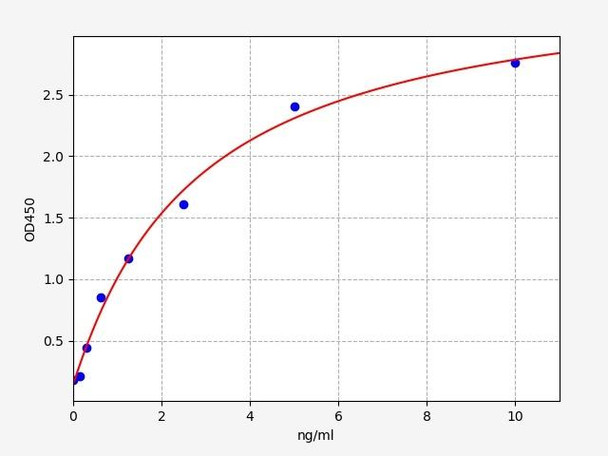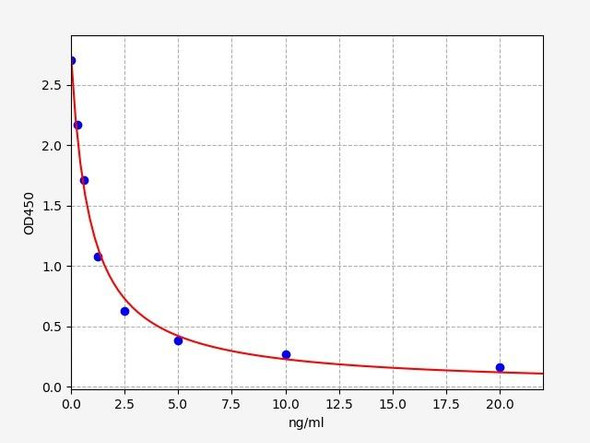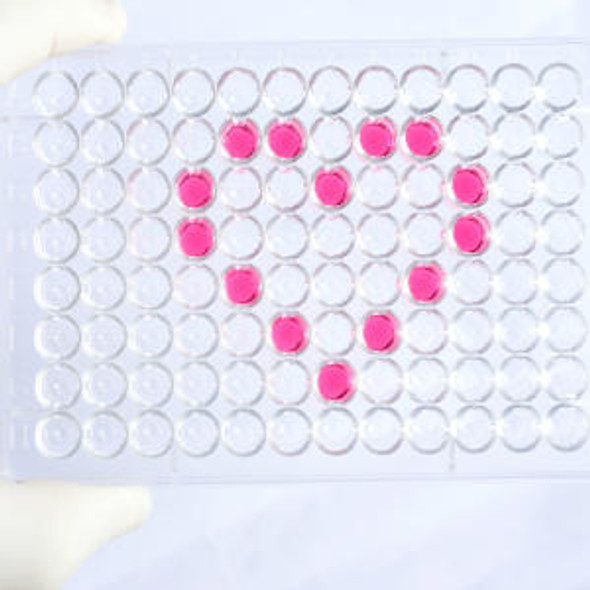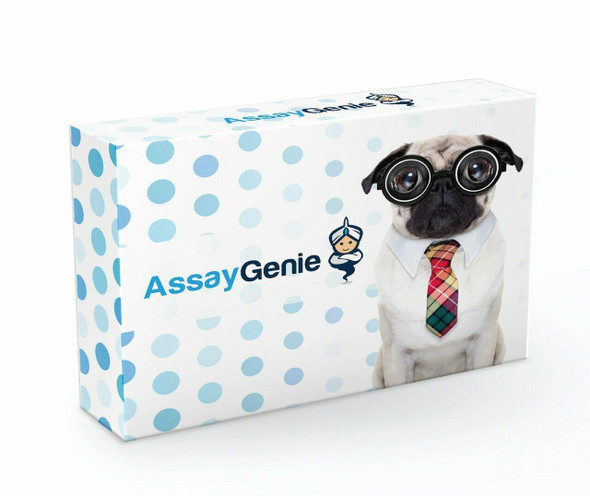Human VCP (valosin-containing protein) ELISA Kit (HUFI05723)
- SKU:
- HUFI05723
- Product Type:
- ELISA Kit
- Size:
- 96 Assays
- Uniprot:
- P55072
- Sensitivity:
- 0.094ng/ml
- Range:
- 0.156-10ng/ml
- ELISA Type:
- Sandwich ELISA, Double Antibody
- Synonyms:
- 15S Mg, 2+ ATPase p97 subunit, IBMPFD, p97, TER ATPase, TERA, valosin containing protein, VCP
- Reactivity:
- Human
Description
| Product Name: | Human VCP (valosin-containing protein) ELISA Kit |
| Product Code: | HUFI05723 |
| Size: | 96 Assays |
| Alias: | 15S Mg ELISA Kit, 2+ ATPase p97 subunit ELISA Kit, IBMPFD ELISA Kit, p97 ELISA Kit, TER ATPase ELISA Kit, TERA ELISA Kit, valosin containing protein ELISA Kit, VCP ELISA Kit |
| Detection method: | Sandwich ELISA, Double Antibody |
| Application: | This immunoassay kit allows for the in vitro quantitative determination of Human VCP (valosin-containing protein) concentrations in serum plasma and other biological fluids. |
| Sensitivity: | < 0.094ng/ml |
| Range: | 0.156-10ng/ml |
| Storage: | 4°C for 6 months |
| Note: | For Research Use Only |
| Recovery: | Matrices listed below were spiked with certain level of Human VCP (valosin-containing protein) and the recovery rates were calculated by comparing the measured value to the expected amount of Human VCP (valosin-containing protein) in samples. Enquire for more information. |
| Linearity: | The linearity of the kit was assayed by testing samples spiked with appropriate concentration of Human VCP (valosin-containing protein) and their serial dilutions. The results were demonstrated by the percentage of calculated concentration to the expected. Enquire for more information. |
| CV(%): | Intra-Assay: CV<8% Inter-Assay: CV<10% |
| Component | Quantity | Storage |
| ELISA Microplate (Dismountable) | 8×12 strips | 4°C for 6 months |
| Lyophilized Standard | 2 | 4°C/-20°C |
| Sample/Standard Dilution Buffer | 20ml | 4°C |
| Biotin-labeled Antibody(Concentrated) | 120ul | 4°C (Protect from light) |
| Antibody Dilution Buffer | 10ml | 4°C |
| HRP-Streptavidin Conjugate(SABC) | 120ul | 4°C (Protect from light) |
| SABC Dilution Buffer | 10ml | 4°C |
| TMB Substrate | 10ml | 4°C (Protect from light) |
| Stop Solution | 10ml | 4°C |
| Wash Buffer(25X) | 30ml | 4°C |
| Plate Sealer | 5 | - |
Other materials and equipment required:
- Microplate reader with 450 nm wavelength filter
- Multichannel Pipette, Pipette, microcentrifuge tubes and disposable pipette tips
- Incubator
- Deionized or distilled water
- Absorbent paper
- Buffer resevoir
| UniProt Protein Function: | VCP: valosin-containing protein (VCP) is a member of a family that includes putative ATP-binding proteins involved in vesicle transport and fusion, 26S proteasome function, and assembly of peroxisomes. VCP, as a structural protein, is associated with clathrin, and heat-shock protein Hsc70, to form a complex. Necessary for the fragmentation of Golgi stacks during mitosis and for their reassembly after mitosis. Involved in the formation of the nuclear envelope and of the transitional endoplasmic reticulum (tER). Regulates NFKappaB pathway, which is important for metastasis of osteosarcoma. Tyrosine phosphorylation regulates its cell cycle-dependent nuclear localization. |
| UniProt Protein Details: | Protein type:Endoplasmic reticulum; EC 3.6.4.6; DNA repair, damage; Chaperone; Hydrolase Chromosomal Location of Human Ortholog: 9p13.3 Cellular Component: nucleoplasm; proteasome complex; endoplasmic reticulum membrane; intracellular membrane-bound organelle; perinuclear region of cytoplasm; endoplasmic reticulum; cytoplasm; lipid particle; cytosol; nucleus Molecular Function:protein domain specific binding; identical protein binding; protein binding; ATPase activity; protein complex binding; ADP binding; polyubiquitin binding; protein phosphatase binding; lipid binding; ATP binding; receptor binding Biological Process: caspase activation; proteasomal ubiquitin-dependent protein catabolic process; ER to Golgi vesicle-mediated transport; ER-associated protein catabolic process; unfolded protein response; protein ubiquitination; DNA repair; regulation of apoptosis; retrograde protein transport, ER to cytosol; bypass DNA synthesis; establishment of protein localization; positive regulation of protein complex assembly; positive regulation of proteasomal ubiquitin-dependent protein catabolic process; double-strand break repair; positive regulation of protein catabolic process; protein amino acid N-linked glycosylation via asparagine; response to DNA damage stimulus; protein homooligomerization Disease: Amyotrophic Lateral Sclerosis 14, With Or Without Frontotemporal Dementia; Inclusion Body Myopathy With Early-onset Paget Disease With Or Without Frontotemporal Dementia 1 |
| NCBI Summary: | The protein encoded by this gene is a member of a family that includes putative ATP-binding proteins involved in vesicle transport and fusion, 26S proteasome function, and assembly of peroxisomes. This protein, as a structural protein, is associated with clathrin, and heat-shock protein Hsc70, to form a complex. It has been implicated in a number of cellular events that are regulated during mitosis, including homotypic membrane fusion, spindle pole body function, and ubiquitin-dependent protein degradation. [provided by RefSeq, Jul 2008] |
| UniProt Code: | P55072 |
| NCBI GenInfo Identifier: | 6094447 |
| NCBI Gene ID: | 7415 |
| NCBI Accession: | P55072.4 |
| UniProt Secondary Accession: | P55072,Q0V924, Q2TAI5, Q969G7, Q9UCD5, B2R5T8, |
| UniProt Related Accession: | P55072 |
| Molecular Weight: | 89,322 Da |
| NCBI Full Name: | Transitional endoplasmic reticulum ATPase |
| NCBI Synonym Full Names: | valosin containing protein |
| NCBI Official Symbol: | VCP |
| NCBI Official Synonym Symbols: | p97; TERA; ALS14; IBMPFD |
| NCBI Protein Information: | transitional endoplasmic reticulum ATPase; TER ATPase; yeast Cdc48p homolog; valosin-containing protein; 15S Mg(2+)-ATPase p97 subunit |
| UniProt Protein Name: | Transitional endoplasmic reticulum ATPase |
| UniProt Synonym Protein Names: | 15S Mg(2+)-ATPase p97 subunit; Valosin-containing protein |
| Protein Family: | Transitional endoplasmic reticulum ATPase |
| UniProt Gene Name: | VCP |
| UniProt Entry Name: | TERA_HUMAN |
*Note: Protocols are specific to each batch/lot. For the correct instructions please follow the protocol included in your kit.
Before adding to wells, equilibrate the SABC working solution and TMB substrate for at least 30 min at 37 °C. When diluting samples and reagents, they must be mixed completely and evenly. It is recommended to plot a standard curve for each test.
| Step | Protocol |
| 1. | Set standard, test sample and control (zero) wells on the pre-coated plate respectively, and then, record their positions. It is recommended to measure each standard and sample in duplicate. Wash plate 2 times before adding standard, sample and control (zero) wells! |
| 2. | Aliquot 0.1ml standard solutions into the standard wells. |
| 3. | Add 0.1 ml of Sample / Standard dilution buffer into the control (zero) well. |
| 4. | Add 0.1 ml of properly diluted sample ( Human serum, plasma, tissue homogenates and other biological fluids.) into test sample wells. |
| 5. | Seal the plate with a cover and incubate at 37 °C for 90 min. |
| 6. | Remove the cover and discard the plate content, clap the plate on the absorbent filter papers or other absorbent material. Do NOT let the wells completely dry at any time. Wash plate X2. |
| 7. | Add 0.1 ml of Biotin- detection antibody working solution into the above wells (standard, test sample & zero wells). Add the solution at the bottom of each well without touching the side wall. |
| 8. | Seal the plate with a cover and incubate at 37 °C for 60 min. |
| 9. | Remove the cover, and wash plate 3 times with Wash buffer. Let wash buffer rest in wells for 1 min between each wash. |
| 10. | Add 0.1 ml of SABC working solution into each well, cover the plate and incubate at 37 °C for 30 min. |
| 11. | Remove the cover and wash plate 5 times with Wash buffer, and each time let the wash buffer stay in the wells for 1-2 min. |
| 12. | Add 90 µL of TMB substrate into each well, cover the plate and incubate at 37 °C in dark within 10-20 min. (Note: This incubation time is for reference use only, the optimal time should be determined by end user.) And the shades of blue can be seen in the first 3-4 wells (with most concentrated standard solutions), the other wells show no obvious color. |
| 13. | Add 50 µL of Stop solution into each well and mix thoroughly. The color changes into yellow immediately. |
| 14. | Read the O.D. absorbance at 450 nm in a microplate reader immediately after adding the stop solution. |
When carrying out an ELISA assay it is important to prepare your samples in order to achieve the best possible results. Below we have a list of procedures for the preparation of samples for different sample types.
| Sample Type | Protocol |
| Serum | If using serum separator tubes, allow samples to clot for 30 minutes at room temperature. Centrifuge for 10 minutes at 1,000x g. Collect the serum fraction and assay promptly or aliquot and store the samples at -80°C. Avoid multiple freeze-thaw cycles. If serum separator tubes are not being used, allow samples to clot overnight at 2-8°C. Centrifuge for 10 minutes at 1,000x g. Remove serum and assay promptly or aliquot and store the samples at -80°C. Avoid multiple freeze-thaw cycles. |
| Plasma | Collect plasma using EDTA or heparin as an anticoagulant. Centrifuge samples at 4°C for 15 mins at 1000 × g within 30 mins of collection. Collect the plasma fraction and assay promptly or aliquot and store the samples at -80°C. Avoid multiple freeze-thaw cycles. Note: Over haemolysed samples are not suitable for use with this kit. |
| Urine & Cerebrospinal Fluid | Collect the urine (mid-stream) in a sterile container, centrifuge for 20 mins at 2000-3000 rpm. Remove supernatant and assay immediately. If any precipitation is detected, repeat the centrifugation step. A similar protocol can be used for cerebrospinal fluid. |
| Cell culture supernatant | Collect the cell culture media by pipette, followed by centrifugation at 4°C for 20 mins at 1500 rpm. Collect the clear supernatant and assay immediately. |
| Cell lysates | Solubilize cells in lysis buffer and allow to sit on ice for 30 minutes. Centrifuge tubes at 14,000 x g for 5 minutes to remove insoluble material. Aliquot the supernatant into a new tube and discard the remaining whole cell extract. Quantify total protein concentration using a total protein assay. Assay immediately or aliquot and store at ≤ -20 °C. |
| Tissue homogenates | The preparation of tissue homogenates will vary depending upon tissue type. Rinse tissue with 1X PBS to remove excess blood & homogenize in 20ml of 1X PBS (including protease inhibitors) and store overnight at ≤ -20°C. Two freeze-thaw cycles are required to break the cell membranes. To further disrupt the cell membranes you can sonicate the samples. Centrifuge homogenates for 5 mins at 5000xg. Remove the supernatant and assay immediately or aliquot and store at -20°C or -80°C. |
| Tissue lysates | Rinse tissue with PBS, cut into 1-2 mm pieces, and homogenize with a tissue homogenizer in PBS. Add an equal volume of RIPA buffer containing protease inhibitors and lyse tissues at room temperature for 30 minutes with gentle agitation. Centrifuge to remove debris. Quantify total protein concentration using a total protein assay. Assay immediately or aliquot and store at ≤ -20 °C. |
| Breast Milk | Collect milk samples and centrifuge at 10,000 x g for 60 min at 4°C. Aliquot the supernatant and assay. For long term use, store samples at -80°C. Minimize freeze/thaw cycles. |









